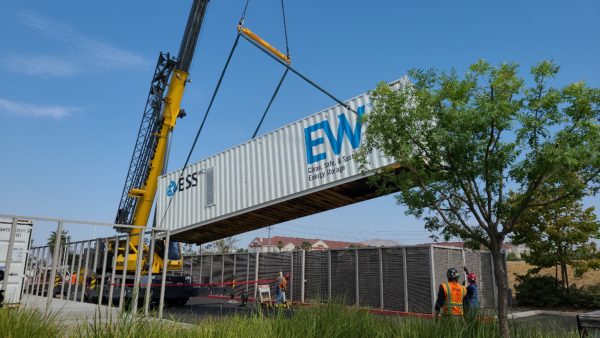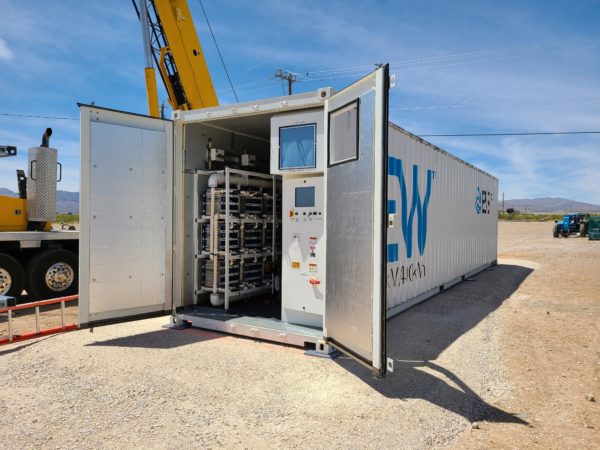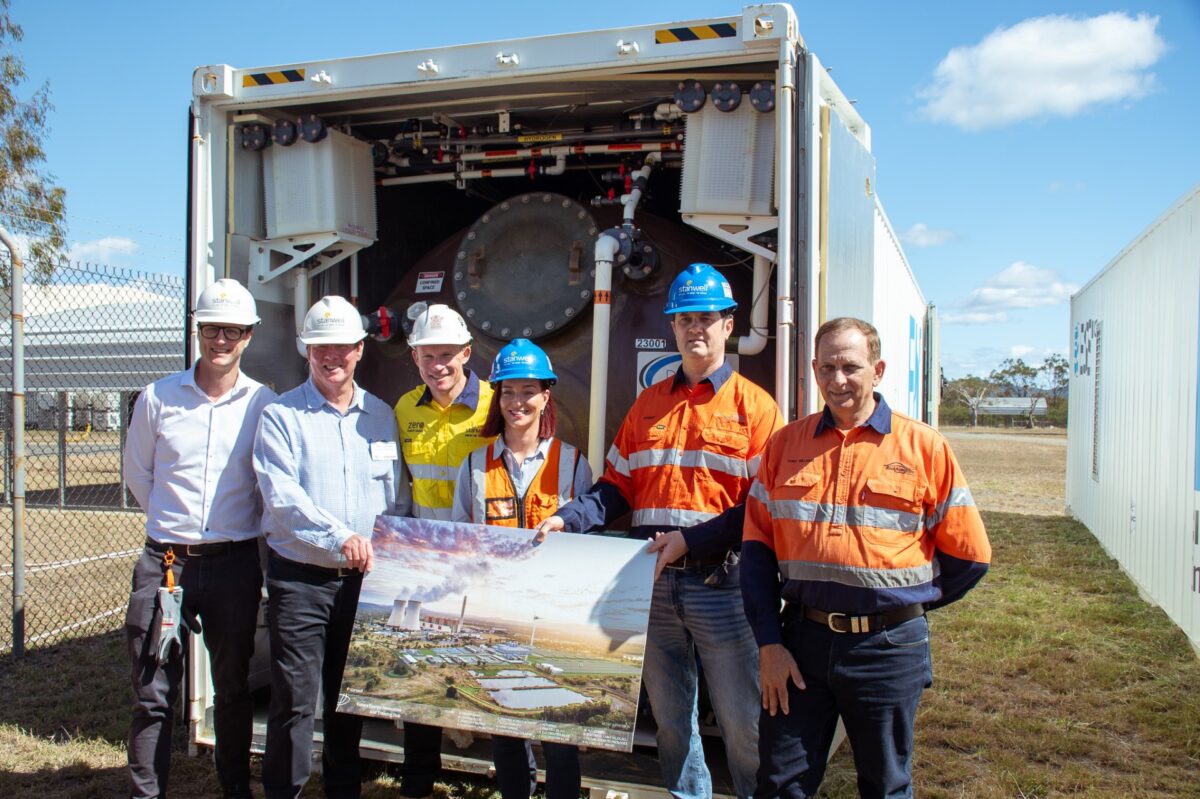The site adjacent to Stanwell Power Station on Queensland’s mid-coast is now home to 10 iron flow batteries, with another 10 to follow suit shortly,* as the state government-owned energy company Stanwell Corporation prepares to transform its soon-to-be retiring coal plant to a $100 million (USD 64 million) hub for renewable commercialisation testing, research, development and training.
The iron flow batteries use the technology of US-based Energy Storage Solutions, better known as ESS. Inc, for which local company Energy Storage Industries owns the Asia-Pacific licence. The pilot batteries are each 12 metres long and have a combined capacity of 1 MW/10 MWh. In its announcement, the Queensland government said the installation marks Australia’s first iron flow battery and the largest such installation in the world.
Energy Storage Industries (ESI) Managing Director, Stuart Parry, told pv magazine Australia the battery project is expected to be operational by September 2024. Once fully commissioned, Stanwell will acquire the flow battery, saying that it is aiming deliver service and maintenance on the pilot.

Image: ESS Inc.
The iron flow battery deal is just one element of the transformation of Stanwell Power Station into the Stanwell Clean Energy Hub. This will include a $100 million Future Energy and Innovation Training Hub (FEITH), described as a shopping centre sized “sandbox” for new technologies in wind, solar, hydrogen and battery storage.
Stanwell is also partnering with hydrogen electrolyser technology company Hysata, a spinoff from research conducted at the University of Wollongong, which claims to have the world’s most efficient electrolysis cell. Stanwell’s Rockhampton hub will host 5 MW pilot project with Hysata’s electrolyser technology to validate its commercialisation potential and technical performance. To that end, Stanwell will provide $3 million and supply the site and facilities for the field deployment of the electrolyser at the site.
While news of the Stanwell coal plant’s transformation was only made Monday, work seems to have already began in the form of the battery delivery, and the government noted it will establish common infrastructure and civil works “in late 2023.”
The Stanwell hub is to be realised in stages, with the announcement flagging the $100 million investment will be deployed over the next five years.
Flow batteries in Queensland
In early August, the Queensland government committed $24 million to further evaluate and assess the capacity of flow battery technology to help the state meet its renewable energy targets. Of that funding, $12 million went towards an iron flow battery from ESI.

Managing Director Parry clarified this funding is in fact going towards a separate installation in Hervey Bay, Queensland, with Energy Queensland Limited, another state-owned entity. That is, ESI is now installing two iron flow battery in the state, with the slightly smaller 1 MW/5 MWh Energy Queensland project also expected to enter operations in September 2024.
Coming back to the Stanwell pilot, the project is seeking test the viability of iron flow batteries for medium duration energy storage, between 8 to12 hours, and assess how the technology deploys at scale. Unlike the more established vanadium flow battery technology, iron flow batteries use an electrolyte solution that its proponents say is “environmentally friendly” since it is made from an earth abundant material, iron.
Thanks to its “deep tech partnership” with ESS Inc., Energy Storage Industries Asia Pacific is currently constructing a $70 million manufacturing plant in Maryborough, Queensland, which is expected to be operational in 2024.
Parry has previously said ESI’s vision is to assemble the iron flow batteries designed by ESS here in Australia sourcing 80% of the components from within Queensland, primarily its regions. Parry has subsequently confirmed the company’s electrolyte solution will be manufactured in Townsville.
Stanwell’s Future Energy and Innovation Training Hub in Rockhampton
Alongside testing innovative new technologies in renewable energy, the government supported Rockhampton hub is also intended to “provide a real-life, hands-on training environment for Queensland energy employees to develop the skills needed to work on renewable energy technologies,” the Queensland government says. Future phases include a skills academy and demonstration centre where the community can come.
The hub has three main purposes, the government says:
Commercialisation testing
- Incubation and acceleration space for pilot energy projects.
- Testing of new technology and develop and drive it to a commercialisation stage.
Research and Development
- A trial site for experimentation, development and testing.
- A space to explore technologies targeted for specific energy solutions for specific purposes.
- A feeder for technologies to be integrated into clean energy hubs.
Training and education
- Training, upskilling and micro-credentials for Stanwell staff and other industry workers.
- Enhancing apprenticeship learning opportunities.
- A demonstration centre where community members, education providers and schools can learn about emerging energy technologies.
Stanwell and CQUniversity (CQU) have also signed an Memorandum of Understanding (MOU) and will partner to develop a skills and training program. Stanwell will complement CQU’s research facilities with access to the Rockhampton hub, enabling real-world applications of research and hands-on training, it says.
Coal to clean power hubs
Part of a much larger trend across Australia, both privately and publicly owned coal power stations are increasingly becoming sites for renewable technologies, most notably energy storage. As Queensland Minister for Energy, Renewables and Hydrogen Mick de Brenni said, this is because these sites are “located in strong parts of the network with strategic advantages like grid connection, [have] a highly skilled workforce, established community relationships, and land.”
The Stanwell Power Station has a capacity of 1.46 GW and is expected to start winding down within the next four years, between 2026 and 2027. As the government noted, the plant is located between the “potential future” Capricorn and Calliope Renewable Energy Zones (REZ) as outlined in Queensland’s Draft REZ Roadmap. Those two zones alone are expected to connect between 1.9 GW and 3.8 GW of new renewable generation.
*This article was amended on August 28 to correct an error. The initial version stated all 20 iron flow batteries had been delivered, when in fact 10 have been delivered with another 10 to be delivered shortly.
This content is protected by copyright and may not be reused. If you want to cooperate with us and would like to reuse some of our content, please contact: editors@pv-magazine.com.









4 comments
By submitting this form you agree to pv magazine using your data for the purposes of publishing your comment.
Your personal data will only be disclosed or otherwise transmitted to third parties for the purposes of spam filtering or if this is necessary for technical maintenance of the website. Any other transfer to third parties will not take place unless this is justified on the basis of applicable data protection regulations or if pv magazine is legally obliged to do so.
You may revoke this consent at any time with effect for the future, in which case your personal data will be deleted immediately. Otherwise, your data will be deleted if pv magazine has processed your request or the purpose of data storage is fulfilled.
Further information on data privacy can be found in our Data Protection Policy.